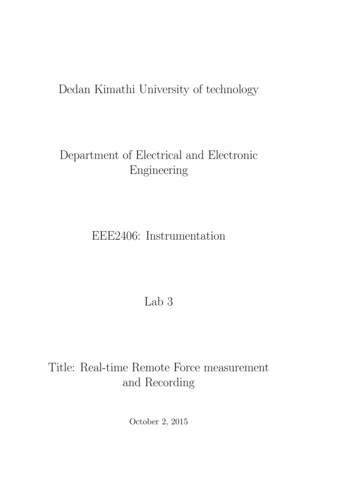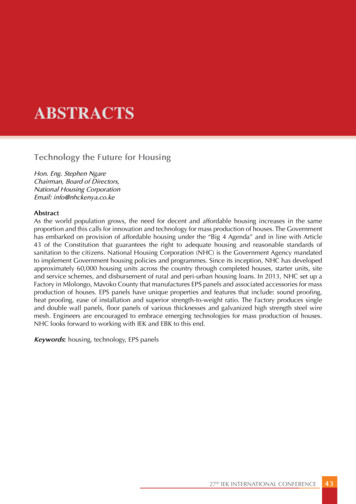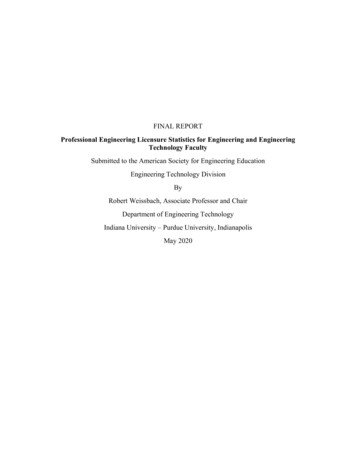
Transcription
Dedan Kimathi University of technologyDepartment of Electrical and ElectronicEngineeringEEE2406: InstrumentationLab 3Title: Real-time Remote Force measurementand RecordingOctober 2, 2015
1Remote Force measurement1.1ObjectivesThe aim of this laboratory practice is to Introduce the student to remote sensing in instrumentation systems Introduce the student to microprocessor application in instrumentation. Demonstrate real time remote force measurement, signal processing, display andRecording in instrumentation systems1.2Requirements1. AD620 chip (operational amplifier)2. MCP3008 chip (analogue to digital converter)3. Load cell (3133 Micro Load Cell - (0-5 kg) - CZL635)4. Weights (0.25 kg, 0.5 kg, 1 kg)5. Raspberry Pi with necessary accessories6. WiFi network dongles7. Breadboard and connectors22.1TheoryIntroductionInstrumentation and measurements is a key area in the field of Electrical and ElectronicEngineering. This is carried out with the use of sensors and transducers. Sensors detectthe quantities to be measured while transducers convert non electrical quantities intoelectrical ones, mainly voltage or current [1].Telemetry is important in instrumentation as it enables collection of data from severalmeasurement points at inconvenient locations or inaccessible areas transmit that data toa convenient location and present the several individual measurements in a usable form [2].Microprocessor based systems are suitable for dedicated and complicated measurementsystems available in modern day industries and hospitals. These microprocessors performcomplicated signal processing operations [2].In measurement systems, the last stage is often the data presentation stage. This consistsof display devices and recorders. The significance of these devices is that they make theresult of measurement meaningful through display of instant observation or storage forobservation at a later stage [2].2
2.2Force Measurement using the Strain gaugeThe stain gauge on the principle that a resistance of a wire of a semiconductor is changedby elongation or compression due to externally applied stress. It is commonly used in themeasurement of force , torque and displacement [1].In this case the measurand is a force and is applied in a column therefore producing strain.The force is first detected converted into strain which is a mechanical displacement. Thisstrain changes the resistance of the strain gauge. Hence we have an output which is achange in the value of resistance. The measurement of force is a 2-stage process i.e firstconversion of force into strain and second conversion of strain into a change in electricalresistance.It is common phenomena that when a metal conductor is stretched or compressed, itsresistance changes on account of the fact that both length and diameter of the conductorchange. Also there is a change in the value of resistivity of the conductor when it isstrained and this property is called piezo-resistive effect.Hence resistance strain gauges are also known as piezo resistive gauges. The resistancechange in strain gauges is small and requires the use of a bridge circuit for measurement,as shown in Figure 1. The strain gauge elements are mounted in two arms of the bridge,and two resistors, R1 and R2 , form the other two arms. The output signal from the bridgeis amplified and impedance matched.Figure 1: Strain gauge bridge circuit2.3Analog to Digital ConversionThe Raspberry Pi computer does not have a way to read analog inputs. It’ s a digital-onlycomputer. Analog inputs are handy because many sensors are analog outputs, so we needa way to make the Pi analog-friendly [3].MCP3008 (analog to digital converter chip) is such a converter. It has 8 analog inputsand the Pi can query it using 4 digital pins. That makes it a perfect addition to the Pifor integrating simple sensors like photocells or potentiometers, thermistors [3]Figure shows the schematic diagram of MCP3008 chip3
Figure 2: MCP3008 Schematic2.4Wireless CommunicationUsing wireless technologies in industrial and factory automation is very attractive formany reasons. The wireless way of communicating makes plant setup and modificationeasier, cheaper, and more flexible [4]. In [4], Bluetooth, Zigbee and WiFi protocols arecompared in terms of power consumption, range of coverage, throughput and number ofnodes that can be supported. The conclusion is that for development of control of wirelessnetworked systems using personal computers, WiFi network is the most effective.3ProcedureThe laboratory exercise will involve the following tasks Force measurement using the strain gauge Transmission of the measured value from the remote location to the control roomusing WiFi wireless network Real time data display and recording section on the Raspberry Pi3.1Force measurementThis includes the transducer and the signal conditioning section. The force signal isdetected using sensor. An amplifier network is used for amplifying the detected signal.Thesignal which is an analog voltage is then converted to digital format before being readinto the Raspberry Pi3.1.1Signal detectionThe sensor used is a load cell (3133 - Micro Load Cell - CZL635, Figure 3)The sensor has four pins (red-power, black-ground, blue and white-outputs). The red pinis connected to 5 V (pin 2 on Pi) and the black pin grounded (pin 39 on pi). The output istaken between the blue and white pins to the signal conditioning section. Figure 4 showsthe Raspberry Pi pin configuration4
Figure 3: Load CellFigure 4: Raspberry Pi Pin Configuration3.1.2Signal conditioningThis consists of the amplifying section and the analog to digital conversion stage.Amplifier SectionAD620 chip used for analog to digital conversion. It is an 8 pin chip, schematic shown inFigure 5The blue pin of the sensor is connected to pin 2 of the AD620 while the white pin to pin3. Pin 7 is connected to 5 V while pin 4 is grounded. A resistor of is connectedbetween pin 1 and 8. This resistor provides for the gain of the amplifier. The output istaken on pin 6Analogue to Digital Conversion SectionThe output of the amplifier (pin 6 of AD620) is connected to channel 0 (pin 1) of the5
Figure 5: AD620 chip SchematicMCP3008 chip. Other pins of the MCP3008 are connected as follows VDD pin (pin 16) connected to 3.3 V (Raspberry Pi pin 1) VREF pin (pin 15) connected to 3.3 V (Raspberry Pi pin 1) AGN D pin (pin 14) connected to ground (Raspberry Pi pin 39) CLK pin (pin 13) connected to General Purpose Input Output GPIO pin 18 (Raspberry Pi pin 12) DOU T pin (pin 12) connected to General Purpose Input Output GPIO pin 23 (Raspberry Pi pin 16) DIN pin (pin 11) connected to General Purpose Input Output GPIO pin 24 (Raspberry Pi pin 18) CS pin (pin 10) connected to General Purpose Input Output GPIO pin 25 (Raspberry Pi pin 22) DGN D pin (pin 9) connected to ground (Raspberry Pi pin 39)A program to read the digital equivalent of the output of the sensor is written in python.See attached Appendix I.3.2Data transmissionThis is achieved via WiFi network. A WiFi dongle is connected to each of the RaspberryPi (one in the field and one in control room). The IP addresses of the two Pis are configured to suite that of the WiFi network.A piece of code is written to read, on the Pi located in the control room, the data streaming on the Pi located in the fieldSee attached Appendix II3.3Data display and storageThis is achieved using mySQL database.6
3.444.1Circuit DiagramResultsAmplified Output Voltage from SensorSR. No123456789101112134.2Weight in (kg) Output Voltage (V)00.250.50.751.01.522.533.544.55Digital Equivalent of Output Voltage from SensorSR. No123456789101112134.3Weight in (kg) Digital Output00.250.50.751.01.522.533.544.55Received values via WiFi networkCapture screen shots of the data streaming on the the Pi7
4.4Stored Data Files in MySQLTake samples of data files from the MySQL database. The database will capture thefollowing informationSR. No123455Date Time Weight in (kg) Digital OutputDiscussionDiscuss the results and carry out error analysis if necessary6ConclusionDraw conclusions based on the outcome of the practical8
References[1] Blackburn J. A., Modern Instrumentation for Scientists and Engineers. Springer,2001.[2] Sawhney A. K., Electrical and Electronic Measurement and Instrumentation.[3] M. Sklar, Analog Inputs for Raspberry Pi using the MCP3008. Adafruit LearningSystem.[4] L. Benmabrouk. Zaineb, Ben Hamed. Mouna, ed., Wireless Control of an InductionMotor, International Journal of Electrical and Electronics Engineering, 2011.9
A program to read the digital equivalent of the output of the sensor is written in python. See attached Appendix I. 3.2 Data transmission This is achieved via WiFi network. A WiFi dongle is connected to each of the Raspberry Pi (one in the eld and one in control room). The IP addresses of the two Pis are con g-ured to suite that of the WiFi .










